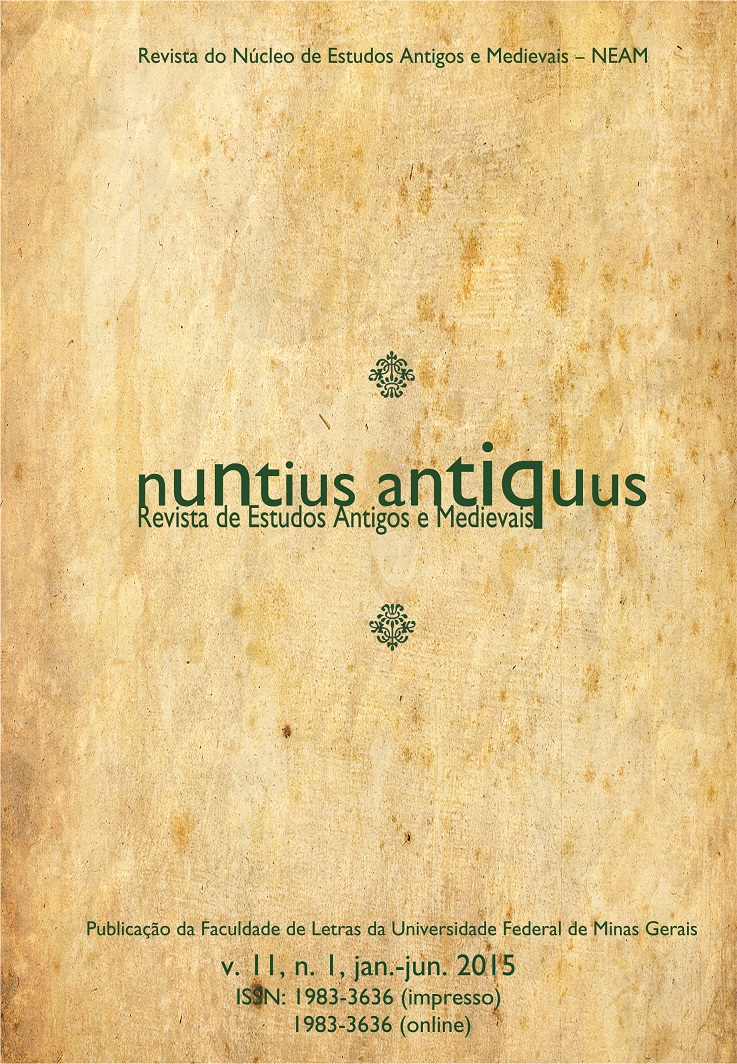Cicero: exile, letters and repetitions
DOI:
https://doi.org/10.17851/1983-3636.11.1.63-87Keywords:
Cicero, epistolography, rethoric, figures of repetition, exileAbstract
Considering the relevance both of Cicero’s letters in the domain of classical studies and of figures of repetition in the rhetorical field, this article aims to verify the use that the famous orator, statesman and Roman writer of the first century BC made of such figures in the 34 letters written by him during his exile that occurred between 58- 57 BC due to a political persecution undertaken by Publius Clodius Pulcher, tribune of the plebs at that time. The methodology of this study is based on the bibliographic review relating to figures of repetition and on a survey of all occurrences of those figures in Cicero’s exilic correspondence, with the aim of interpreting them in order to reveal an underlying communicative intention in the orator’s argumentation. The text shows how the use of such rhetorical resources, in a textual genre generally considered unpretentious in terms of style, helped to enlarge Cicero’s power of persuasion in relation to the original readers of the set of letters composed in one of the most tempestuous periods of his life. Thus, this paper intends to contribute not only to expand the knowledge of the argumentative force of the repetition figures but also to diffuse a significant part of the work of one of the most important names of the universal literature.
References
BOISSIER, C. Cicerone e i suoi amici. Milano: Biblioteca Universale Rizzoli, 1988.
BRANDÃO, R. O. As figuras de linguagem. São Paulo: Ática, 1989. CARDOSO, Z. A. A literatura latina. 2ª ed. São Paulo: Martins Fontes, 2003.
CONSTANS, L. A. Notice. In: CICÉRON. Correspondance. Trad. L. A. Constans. Paris: Les Belles Lettres, 1950. Vol. 2, p. 12-81.
EVERITT, A. Cicero: the life and times of Rome’s greatest politician. New York: Random House, 2003.
FIORIN, J. L. Figuras de retórica. São Paulo: Contexto, 2014. GENETTE, G. Figuras. Trad. Ivonne Floripes Mantoanelli. São Paulo: Perspectiva, 1972.
LAUSBERG, H. Elementos de retórica literária. Trad. R. M. Rosado Fernandes. 5ª ed. Lisboa: Calouste Gulbenkian, 2004.
MAINGUENEAU, D. Discurso literário. São Paulo: Contexto, 2006. MAROUZEAU, J. Traité de stylistique latine. 2eed. Paris: Les Belles Lettres, 1946.
MARTIN, R.; GAILLARD, J. Les genres littéraires à Rome.Paris: Nathan/Scodel, 1990.
MÖLLER, L. Berühmte Briefe: Briefe aus dem Exil Szenen einer Ehe. Wiesbaden: MarixVerlag, 2009.
PERELMAN, C.; OLLBRECHTS-TYTECA, L. Tratado da argumentação: a nova retórica. Trad. Maria Ermantina de Almeida Prado Galvão. São Paulo: Martins Fontes, 2005.
PERRINE, L; ARP, T. R. Sound and sense: an introduction to poetry. 8a. ed. Fort Worth: Harcourt Brace College, 1992.
PLEBE, A.; EMANUELE, P. Manual de retórica. Trad. Eduardo Brandão. São Paulo: Martins Fontes, 1992.
PLUTARCO. Vidas paralelas: Demóstenes e Cícero. Trad., introd. e notas de Marta Várzeas. Coimbra: CECH, 2010.
QUINTILIANO, M. F. Institution oratoire. Paris: Les Belles Lettres, 1980.
Retórica a Herênio. Trad. e introdução de Ana Paula Celestino Faria e Adriana Seabra. São Paulo: Hedra, 2005.
SARAIVA, F. R. S. Novíssimo dicionário latino-português. 10ª ed. Belo Horizonte/Rio de Janeiro: Garnier, 2006.
STAIGER, E. Conceitos fundamentais da poética. Trad. Celeste Aída Galeão. 3a ed. Rio de Janeiro: Tempo Brasileiro, 1997.
TODOROV, T. Literatura e significação. Trad. Antônio José Massano. Lisboa: Assírio & Alvim, 1973.
TRINGALI, D. Introdução à retórica: a retórica como crítica literária. São Paulo: Duas Cidades, 1988.





